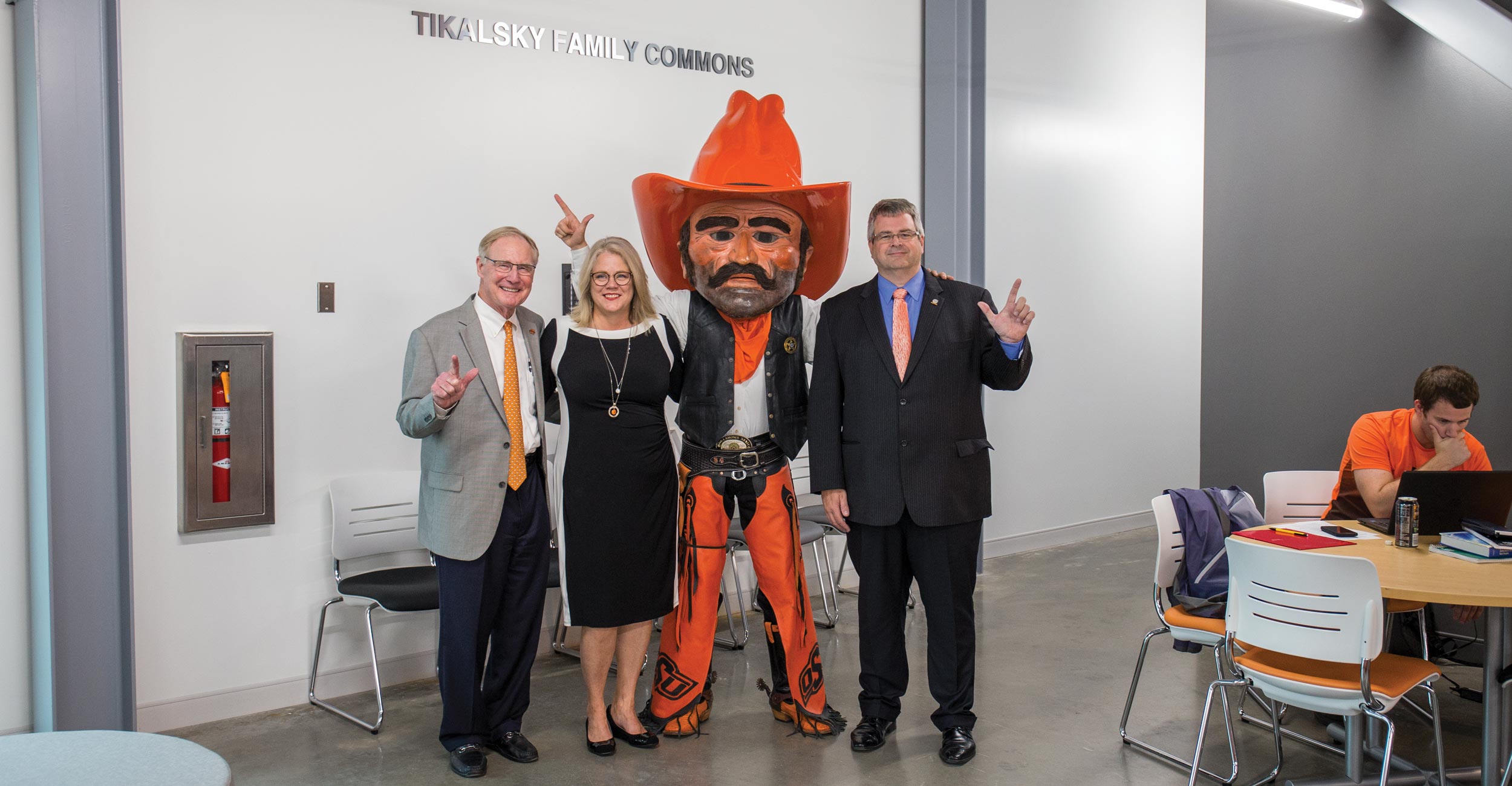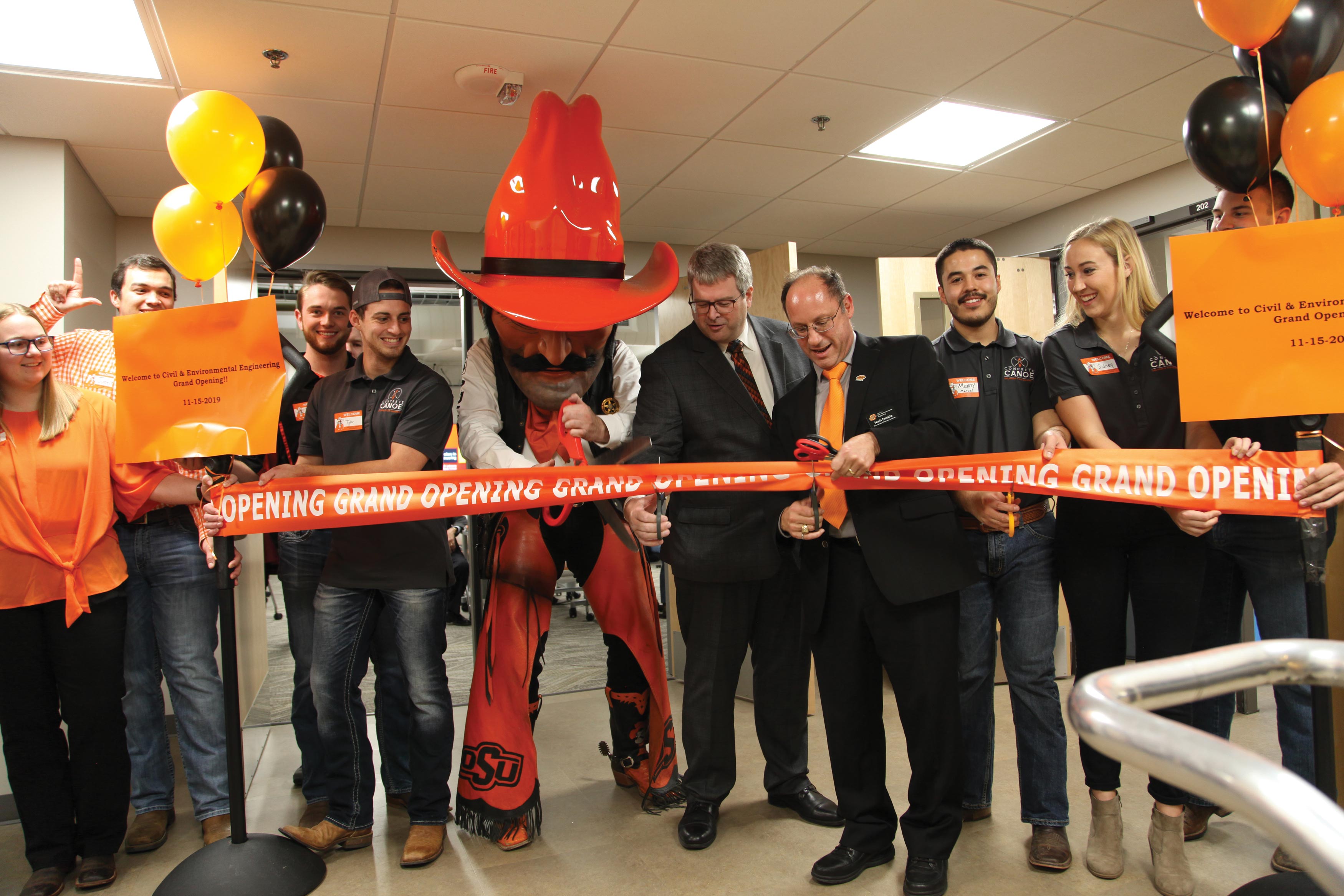
Stepping Down: Dr. Paul Tikalsky leaving his role after 11 years at the helm of CEAT
Monday, September 25, 2023
Media Contact: Kristi Wheeler | Manager, CEAT Marketing and Communications | 405-744-5831 | kristi.wheeler@okstate.edu
Fall 2023 marks 11 years since Dean Paul Tikalsky took over leadership for the College of Engineering, Architecture and Technology.
Since then, the college and its people have seen transformational growth in all areas: enrollment; scholarships; infrastructure; industry partnerships; faculty hires; student enrollment and retention; outreach and engagement; and instruction and research.
After more than a decade of accomplishments, Dr. Tikalsky decided it’s time for him to step down as dean and allow for new leadership to step in.
The decision was his, as he realized 11 years is a long time to serve as dean. A dean’s typical term length lasts three to five years. When the new Oklahoma State University administration started, he said it was only right to give President Kayse Shrum a chance to select her own leaders.
Tikalsky spent more than 4,000 days leading, coaching and mentoring over 4,000 students and raising money to help them graduate. Among his several achievements, Tikalsky was responsible for raising more than $250 million to support world-class learning facilities and programs, scholarships, endowed chairs, industry research partnerships and K12 STEM programs.
“When I started, I knew that we needed to move into the 21st century and our facilities were not what our peers looked like,” Tikalsky said. “The addition of ENDEAVOR, EXCELSIOR, the Bert Cooper Lab, and the Harold R. Mace Meeting and Learning Center as well as the renovations of Engineering North and South, Parker Hall and the Student Excellence Center, all these things have changed our lab and research environment to one that is much more aligned with the future and innovation. And now, the Zink Center for Competitive Innovation will make an impact on that as well.
“From a facilities standpoint, we are at a very different place now than we were 11 years ago. This helps us recruit faculty, staff and students, which is not only great for 21st century recruiting and education, but also helps us to retain them.”
Retention rates for students have increased by over 90%. Graduation rates have also increased by 26%.
“The ultimate goal of my tenure is to position OSU CEAT to recruit and hire a highly qualified candidate to take over as the next full-time dean so that I can return to my retirement. We all owe a debt of gratitude to Dean Tikalsky for his work for the faculty, staff and students in CEAT.”
This is in part because of the retention initiatives set in place. Programs such as the PreCEAT Program, the Summer Bridge Program, the Parker Hall Living Learning Program, CEAT’s PEATES Program, CEAT tutoring and the CEAT Diversity, Equity and Inclusion Program were all initiated with the intention of retaining students and giving them the maximum opportunity to excel to their fullest potential.
Student enrollment continues to increase, due in part to the number of scholarships that CEAT can give. On average, over $3 million in scholarships a year is provided to CEAT students.
“We are not only looking at high achieving students to award scholarships to, but we also look at economically challenged students, underrepresented students and students who are in financial need, but still students who have the potential to be tomorrow’s leaders,” Tikalsky said.
The constantly increasing demand for engineers has also challenged CEAT to place an even greater emphasis on recruiting than it already has. Recently, CEAT was awarded a $5 million Department of Defense grant focused on STEM education for K12 students and faculty members across the state.
“We’re trying to find the talent in every town, large and small, in Oklahoma and beyond,” Tikalsky said. “We need to grab that talent, no matter its circumstances, and give it the ability to innovate and change the world.”
This past summer, CEAT offered 35 STEM camps to 2,000 K-12 students across 13 cities in Oklahoma, record numbers for the college.
In addition to setting recruitment and retention records, Tikalsky opened many faculty positions to support the student increase. Since 2012, over 125 new faculty have been hired, making two-thirds of the entire faculty in CEAT under the age of 40, some being clinical and some being research oriented.
“These things have changed the culture in the college,” Tikalsky said. “As we looked at the strategic planning, we had industry and advisory boards and CEOs and VPs help us see what they needed from us.”
In addition to academics and research, CEAT’s Extension units have seen tremendous growth over the last 11 years, serving more than 150,000 individuals across the nation per year.
Tikalsky said the more he learned about leadership, the more he understood that it is supposed to change because it is healthy for faculty and students.

“I am excited to see what the new administration has in store,” Tikalsky said. “I think the administration here has defined a strategy they want to move forward with. This is a new direction for the university. I think they’re spending time and effort on that (strategic planning). All these things are how a leader chooses what avenues to move after.”
As Tikalsky steps down, Dr. John Veenstra, Professor Emeritus of Civil and Environmental Engineering (CIVE), will act as interim dean.
During his long tenure at OSU, Veenstra served as a professor of CIVE, the department head of CIVE, and the department head of Biosystems and Agricultural Engineering in the Division of Agricultural Sciences and Natural Resources.
Before his retirement in 2021, Veenstra was an active member of various college and university committees including serving as chair of the OSU Faculty Council and of the Oklahoma State Regents for Higher Education Faculty Advisory Council. Veenstra’s areas of expertise include water and wastewater treatment, air pollution treatment and groundwater treatment, and is a registered professional engineer in Oklahoma and Iowa.
“Few opportunities could draw me out of retirement, but the ability to work with the college leaders, faculty, staff and students to grow going forward was one that I couldn’t pass up,” Veenstra said. “I hope to leave CEAT a better place as the new dean assumes their responsibilities.”
Veenstra said his plan is to continue CEAT’s positive momentum established during Tikalsky’s tenure.
“With the grand reopening of Engineering South, this will complete the exceptional academic infrastructure modernization of the college overseen by Dean Tikalsky, which is second to none,” Veenstra said. “The various units inside CEAT will move to further implement OSU’s strategic plan and will work to continue and expand our interactions with the other colleges. It is important to CEAT and OSU that we establish lines of communication — both across our own college and with the other colleges — so that we are positioned to take advantage of research and extension opportunities that we find. Together, we can make a difference. In the instruction arena, we will continue to engage, inspire and prepare CEAT students to innovate solutions to all ranges of problems in their chosen fields.
“The ultimate goal of my tenure is to position OSU CEAT to recruit and hire a highly qualified candidate to take over as the next full-time dean so that I can return to my retirement. We all owe a debt of gratitude to Dean Tikalsky for his work for the faculty, staff and students in CEAT.”
As Tikalsky steps down, he will return to his tenured faculty position in CIVE as he, Veenstra and Dr. Jeanette Mendez, OSU provost and senior vice president of academic affairs, will work together on a comprehensive and thoughtful transition plan and begin a national search for a new dean.
Tikalsky grew up in Wisconsin, which is where he and his wife, Julie, will go after he decides he’s ready to retire. The couple bought some land on the coastline of Lake Michigan, where they plan to build a home and spend time.
“I heard on NPR someone talking about this concept of wonder,” Tikalsky said. “If you stare at the leaf of a tiny flower and if you put it under a microscope, or just under a magnifying glass, you just see how complex it is. And this gives you an idea of wonder, gives you a rush, right? And so, you think about that every day. And I think that’s true. I think that’s exactly the way I see the world every day as a dean.”
Photos: Kristi Wheeler, Phil Shockley and Gary Lawson
Story by: Kristi Wheeler | IMPACT Magazine
